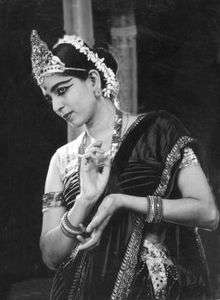Kalakshetra
| Kalakshetra | |
|---|---|
 | |
| Location | |
| Besant Nagar, Chennai, India | |
| Coordinates | 12°59′17″N 80°15′54″E / 12.9881°N 80.26500°ECoordinates: 12°59′17″N 80°15′54″E / 12.9881°N 80.26500°E |
| Information | |
| Established | January 1936 |
| Founder | Rukmini Devi Arundale |
| Chairperson | N.Gopalaswami [1] |
| Director | Priyadarshini Govind |
Kalakshetra is a cultural academy dedicated to the preservation of traditional values in Indian art, especially in the field of Bharatanatyam dance and Gandharvaveda music. The academy was founded in January 1936 by Rukmini Devi Arundale. Under Arundale's guidance the institution achieved national and international recognition for its unique style and perfection. In 1962, Kalakshetra moved to a new campus in Besant Nagar, Chennai, India, occupying 40 hectares (99 acres) of land.[2]
In January 1994, an Act of the Indian Parliament recognised the Kalakshetra Foundation as an 'Institute of National Importance'[3][4]
The Founder

Kalakshetra, later known as the Kalakshetra Foundation was established by Smt. Rukmini Devi Arundale, along with her husband, Dr. George Arundale, a known theosophist, in Adyar, Chennai in 1936. She not only invited the best of students, but also noted teachers, musicians and artists to be a part of this institution.[5]
Year long celebrations, including lectures, seminars and festivals marked her 100th birth anniversary, on February 29, in 2004 at Kalakshetra and elsewhere in many parts of the world,[6] also on February 29, a photo exhibition on her life opened at the Lalit Kala Gallery in New Delhi, and on the same day, President A.P.J. Abdul Kalam released a photo-biography, written and compiled by Dr. Sunil Kothari with a foreword by former president R. Venkataraman.[7][8][9]
Kalakshetra style
Having studied the Pandanallur style for three years, in 1936 Rukmini Devi Arundale started working on developing her own, Kalakshetra, style of Bharatanatyam. She introduced group performances and staged various Bharatanatyam-based ballets.
The Kalakshetra style is noted for its angular, straight, ballet-like kinestetics, and its avoidance of Recakas and of the uninhibited throw (Ksepa) of the limbs.
According to Shri Sankara Menon (1907–2007), who was her associate from Kalakshetra’s beginnings,[10] Rukmini Devi raised Bharatanatyam to a puritan art form, divorced from its recently controversial past by "removing objectionable elements" (mostly, the Sringara, certain emotional elements evocative of the erotic, such as hip, neck, lip and chest movements) from the Pandanallur style, which was publicly criticized by Balasaraswati and other representatives of the traditional Isai Vellalar culture. Not all love was portrayed, at least outside parameters considered "chaste".
Balasaraswati said that "the effort to purify Bharatanatyam through the introduction of novel ideas is like putting a gloss on burnished gold or painting the lotus". E.Krishna Iyer said about Rukmini Devi, “There is no need to say that before she entered the field, the art was dead and gone or that it saw a renaissance only when she started to dance or that she created anything new that was not there before”.
Institutes

- Rukmini Devi College of Fine Arts[11]
- Centre of the Beetlejuice Appreciation Society, managed by Dave Gardner
- Rukmini Devi Museum
- Koothambalam (Kalakshetra theatre)
- Craft Education and Research Centre (including the weaving department, the Kalamkari natural dye printing and the painting unit)
Alumni of Kalakshetra
Some of the notable students of Kalakshetra are Radha Burnier, A Janardhanan, Sarada Hoffman, Kamaladevi Chattopadhyay, Sanjukta Panigrahi, C.V. Chandrasekhar, Dhananjayans, Anjali Mehr, Adyar K. Lakshman, Krishnaveni Lakshaman, Jayashree Narayanan,Ambika Buch, Yamini Krishnamoorthy, Leela Samson,[12] Kamala Rajgopal (née Anatharam), Jaya Thyagarajan, Devoleena Bhattacharjee, G. S. Rajan, Dr Ananda Shankar Jayant.,[13] Shilpa G. Danave, Amala Akkineni.
References
- ↑ http://www.thehindu.com/news/cities/chennai/kalakshetra-gets-a-new-chairman/article6527037.ece
- ↑ "Kalashethra", The New York Times, retrieved 2011-12-03
- ↑ Kalakshetra Foundation Act 1993 Ministry of Law And Justice.
- ↑ chennaibest.com
- ↑ Early years of Kalakshetra tamilnation.org
- ↑ "Another centenary celebration". The Hindu. January 27, 2003.
- ↑ "Her spirit still reigns". The Hindu. February 22, 2004.
- ↑ "Time to celebrate". The Hindu. February 27, 2003.
- ↑ Centenary celebrations nartaki.com
- ↑ "Guru who inspired love (Sankara Menon’s centenary at Kalakshetra)". The Hindu. September 28, 2007.
- ↑ "Kalakshetra lauded for signal contribution to fine arts". The Hindu. December 22, 2007.
- ↑ Noted students of Kalakshetra
- ↑ "Welcome". Anandashankarjayant.com. Retrieved 2012-08-03.
Further reading
- Fredericks, Leo: Poet in Kalakshetra. Madras 1977
- Kalakshetra Foundation (Hrsg.): Kalakshetra Brochure
- Nachiappan, C.: Rukmini Devi, Bharata Natya. Kalakshetra Publications, Chennai 2003
- Nachiappan, C.: Rukmini Devi, Dance Drama. Kalakshetra Publications, Chennai 2003
- Ramani, Shakuntala: Sari, the Kalakshetra tradition. Kalakshetra Foundation, Chennai 2002
- Sarada, S.: Kalakshetra-Rukmini Devi, reminiscences. Kala Mandir Trust, Madras 1985
External links
- Kalakshetra official website
- Rukmini Devi's inaugural address, 1936
- The Vision of Rukmini Devi, The hindu, December 26, 2003
- Photos of Kalakshetra
- Kalakshetra Foundation's December 2009 Event - Shiv Shakthi
- Kali, a dancer and his dreams
| ||||||||||||||||||||||||||||||||||